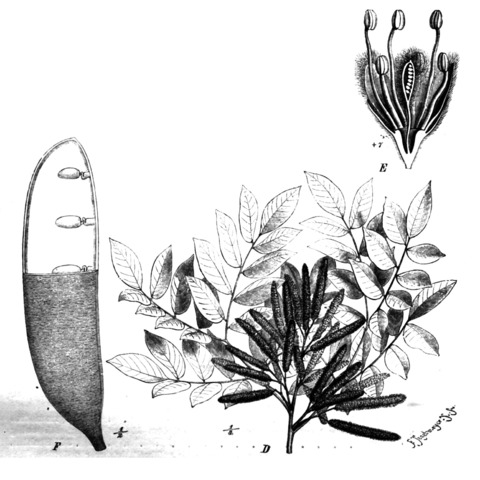A large tree. It grows 40 m tall and is 2.5 m around. The trunk is 10-16 m tall and often has buttresses. The bark is grey and poisonous. The leaves are twice divided and have 3-4 pairs of smaller leaflet shoots. These are 15-30 cm long and arranged oppositely. Along these there are 8-14 leaflets that are 5-10 cm long by 3-4 cm wide. The flowers are yellow to red and in dense crowded spike like stalks. These are 8-10 cm long and 18 mm across. The fruit are woody pods 8-15 cm long by 4-5 cm wide. They are flat and rounded at both ends. The seeds are hard and 8 mm long.
Leaves: petiole and rachis together (6)11–35 cm long; pinnae 2–4(5) pairs; pinna rachis 8–20 cm long; leaflets (6)9–13(15) per pinna, (3)4.5–7(9) × (1.5)2.2–4.5(5.3) cm, obliquely ovate to elliptic, the base asymmetrical (except the terminal leaflet), the apex bluntly acuminate, i.e. drawn out into a short 'drip-tip', the surfaces glabrous except on the midrib beneath which is usually strongly pubescent; petiolules 2–4.5(5) mm long.
Pods (7)10–14(17) × 3–4.5(5.3) cm excluding the stipe, oblong or somewhat curved, rounded at both ends, often somewhat woody, dehiscing along one margin only; stipe (1)1.5–2(2.5) cm long, inserted ± asymmetrically; seeds (4)6–9 × 10–12 × 4–7 mm, oblong-ellipsoid, on a funicle 7–10 mm long.
Racemes 2.5–8(11) cm long including a peduncle 0.7–1.5 cm long, the axis and peduncle densely puberulous to pubescent with short, crisped, appressed, rusty-brown hairs.
Flowers 6–8(9) mm long from base of pedicel to anthers, cream or lemon-yellow to greenish-yellow; pedicel 0.6–1 mm long at anthesis.
Calyx 1–2(2.5) mm long, fused for almost half its length, rusty-brown pubescent like the inflorescence axis.
Young branches and leaf rachides glabrous to shortly pubescent.
Tree up to 30 m high; bark dark brown, very rough.
Petals 2–3.5 mm long, greyish-brown pubescent.
Stamen filaments glabrous.


